Sir John Monash, Personal Files Book 15, 1 April - 10 May 1917, Part 17
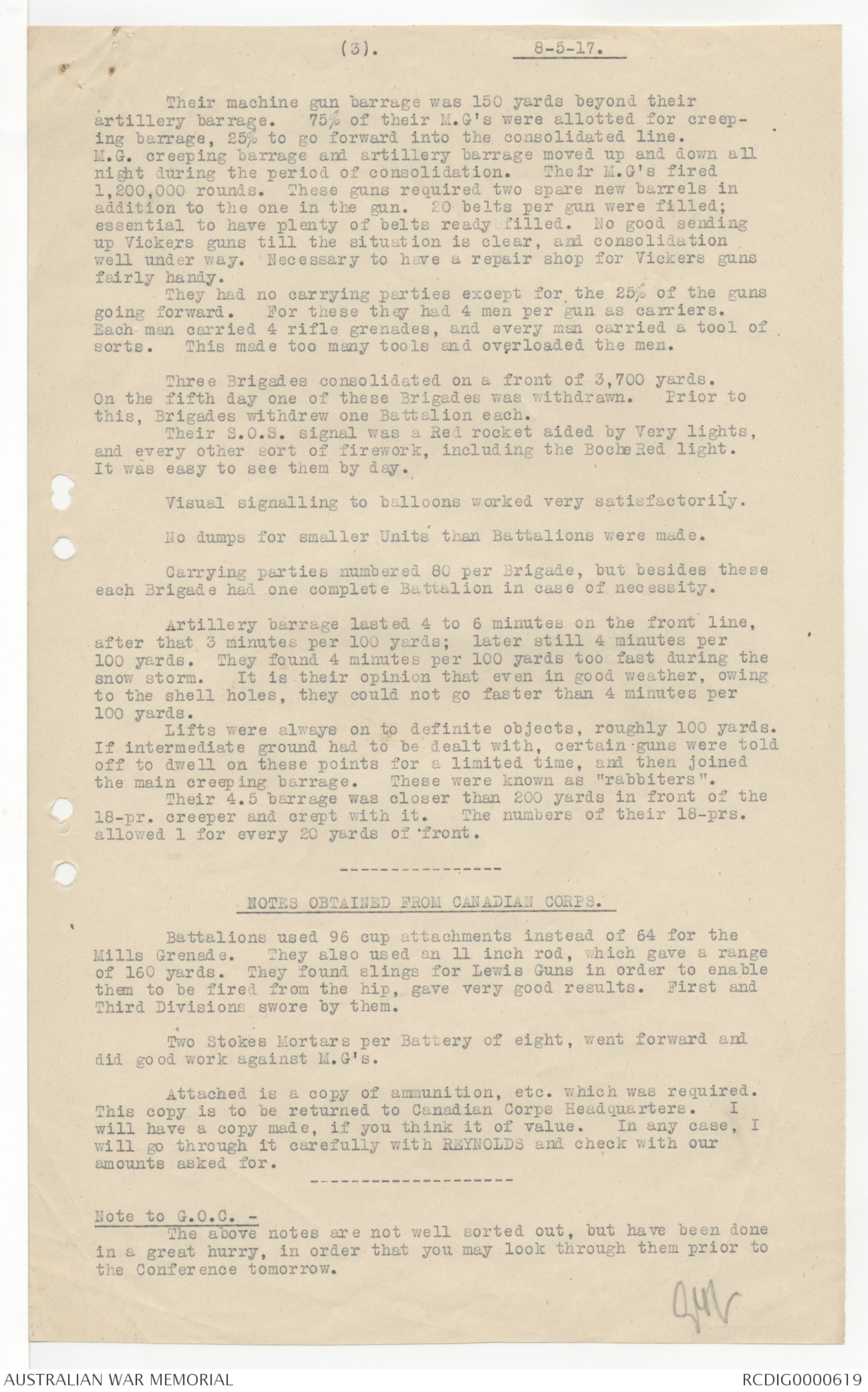
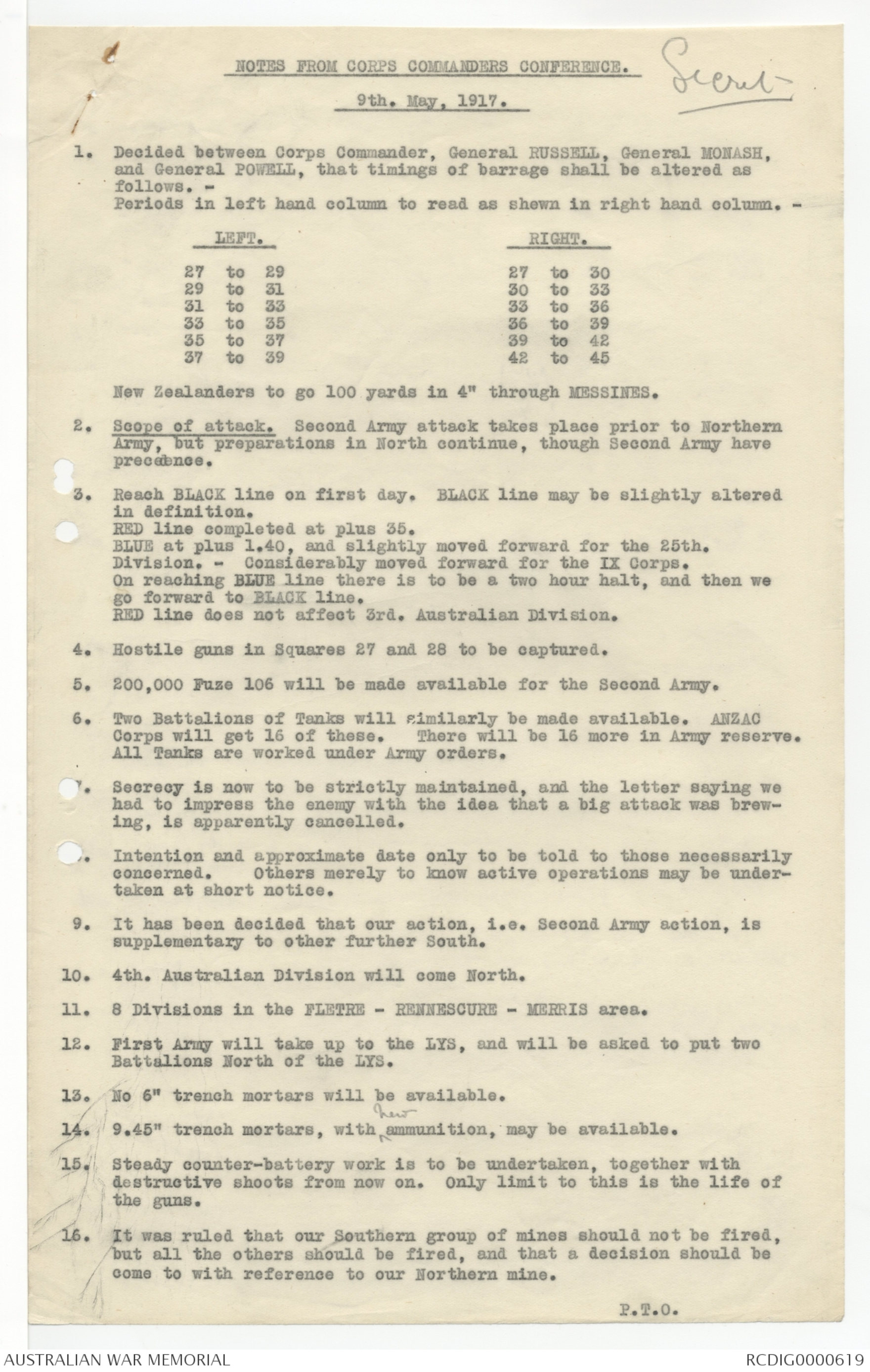
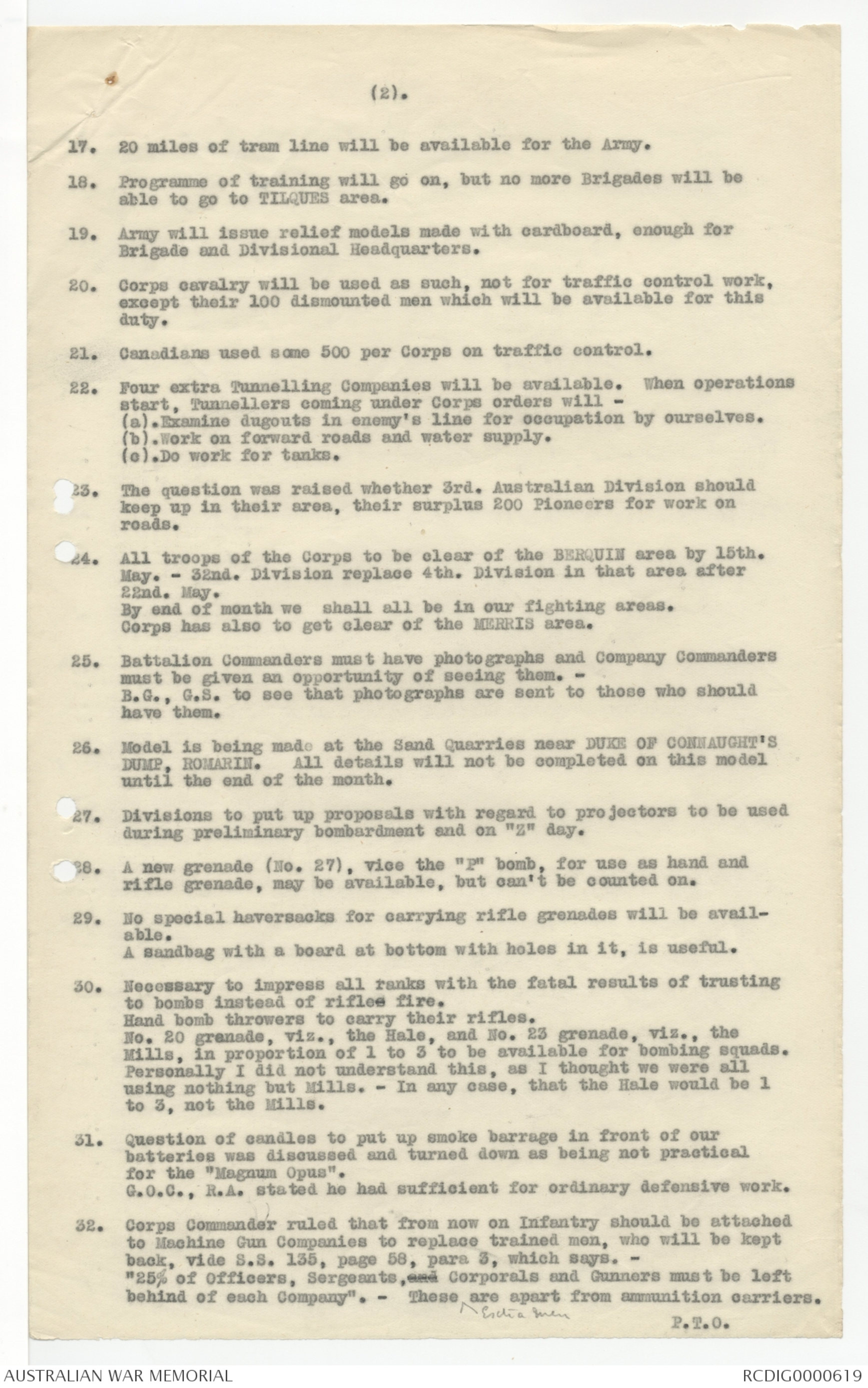
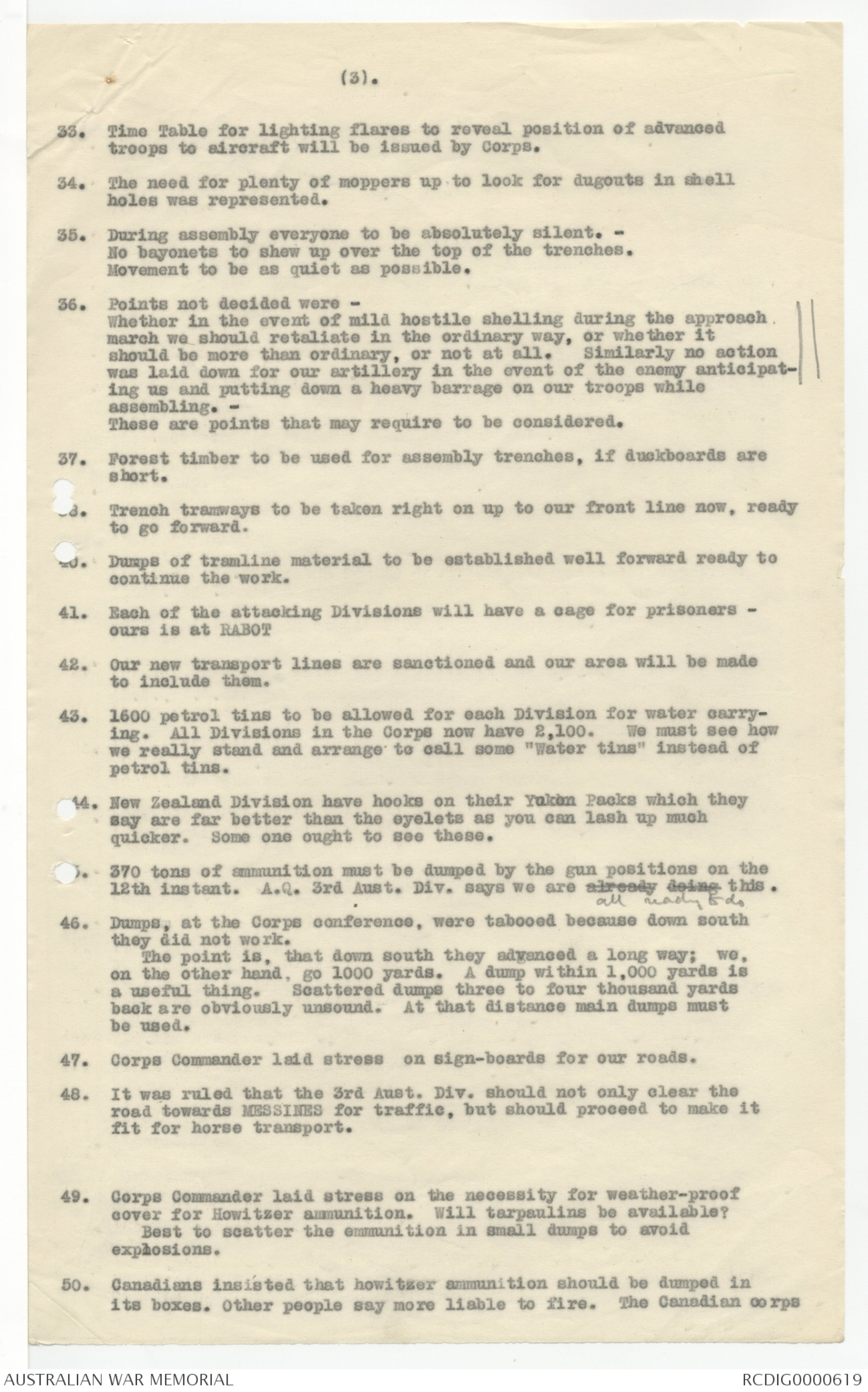
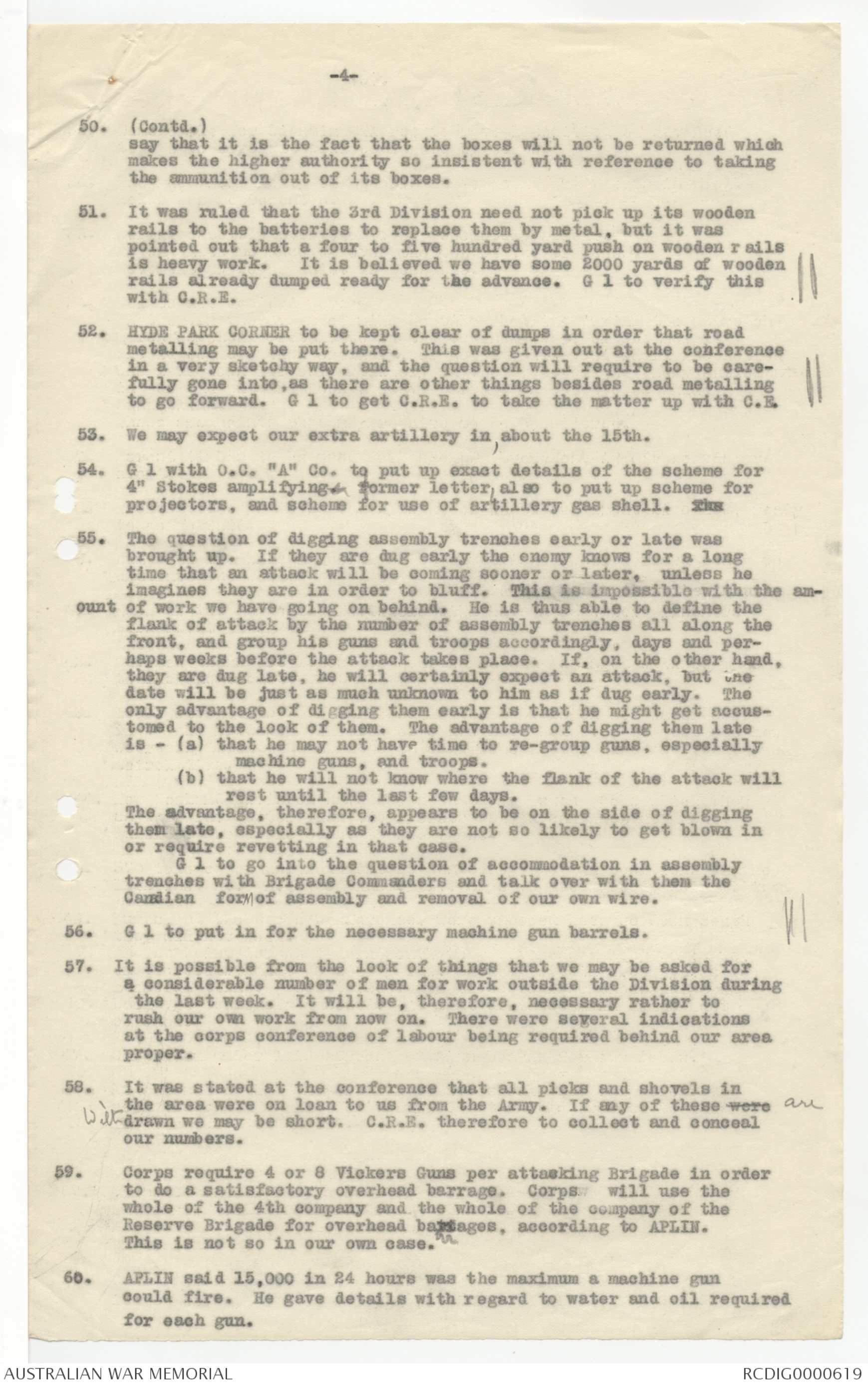
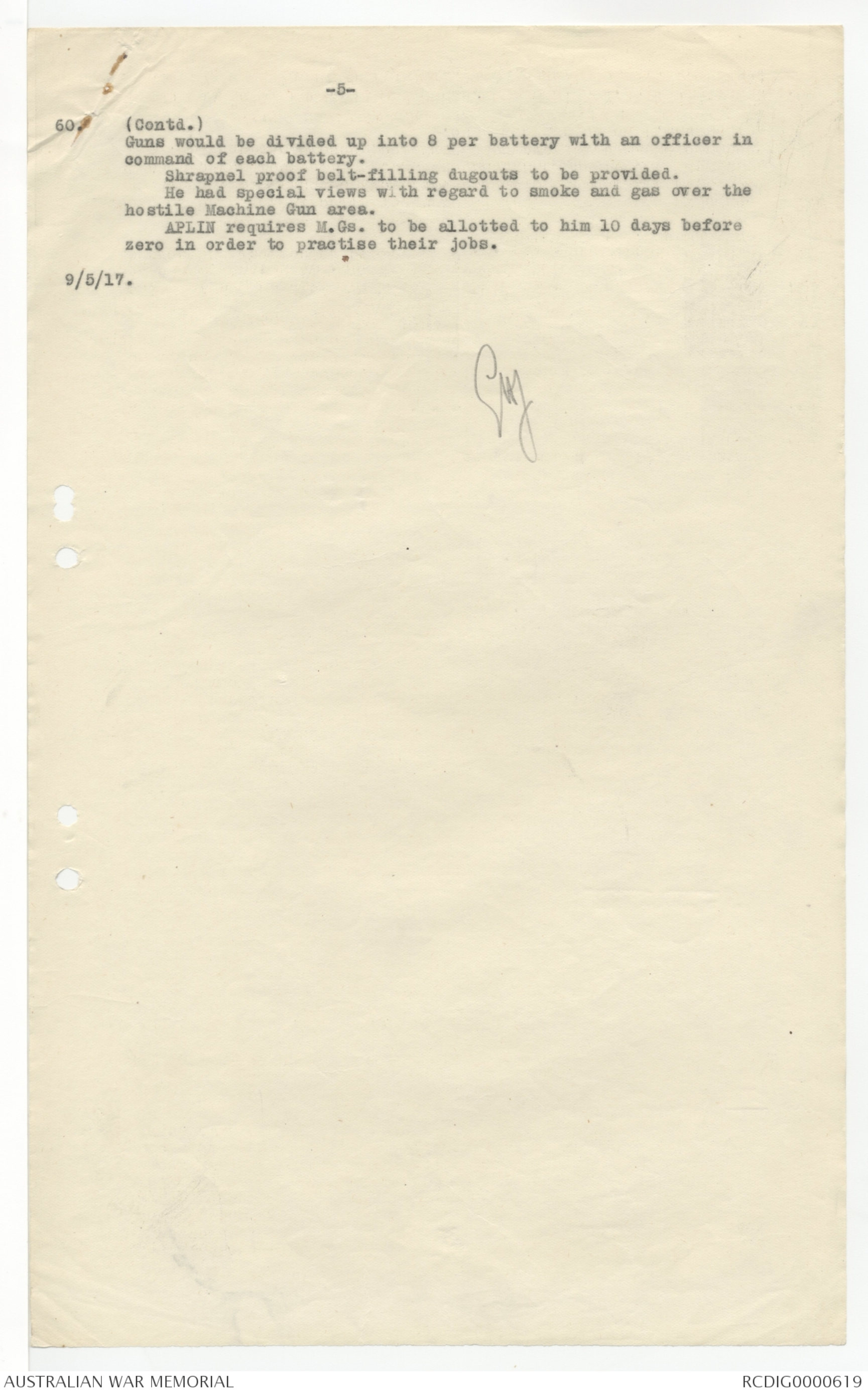
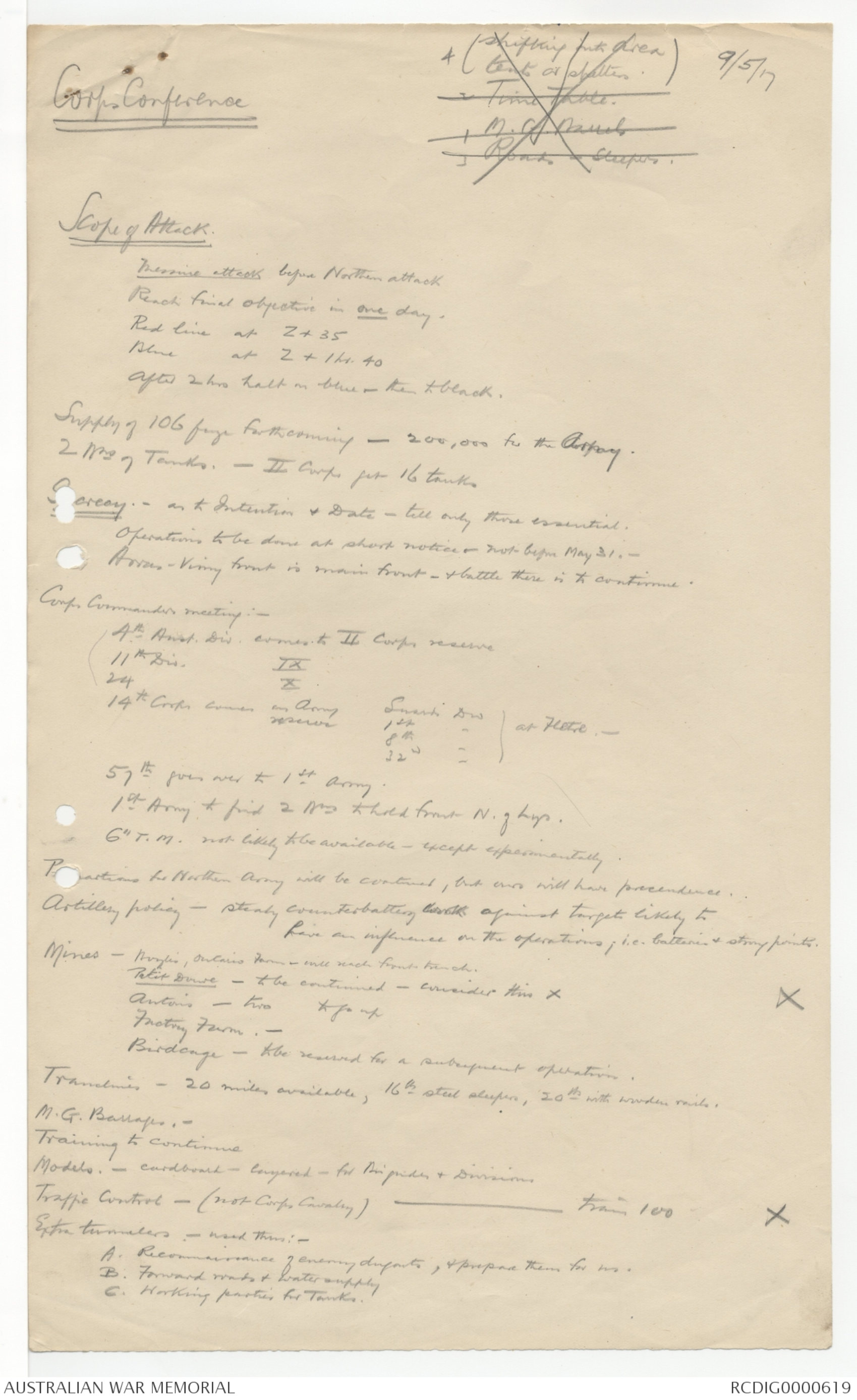
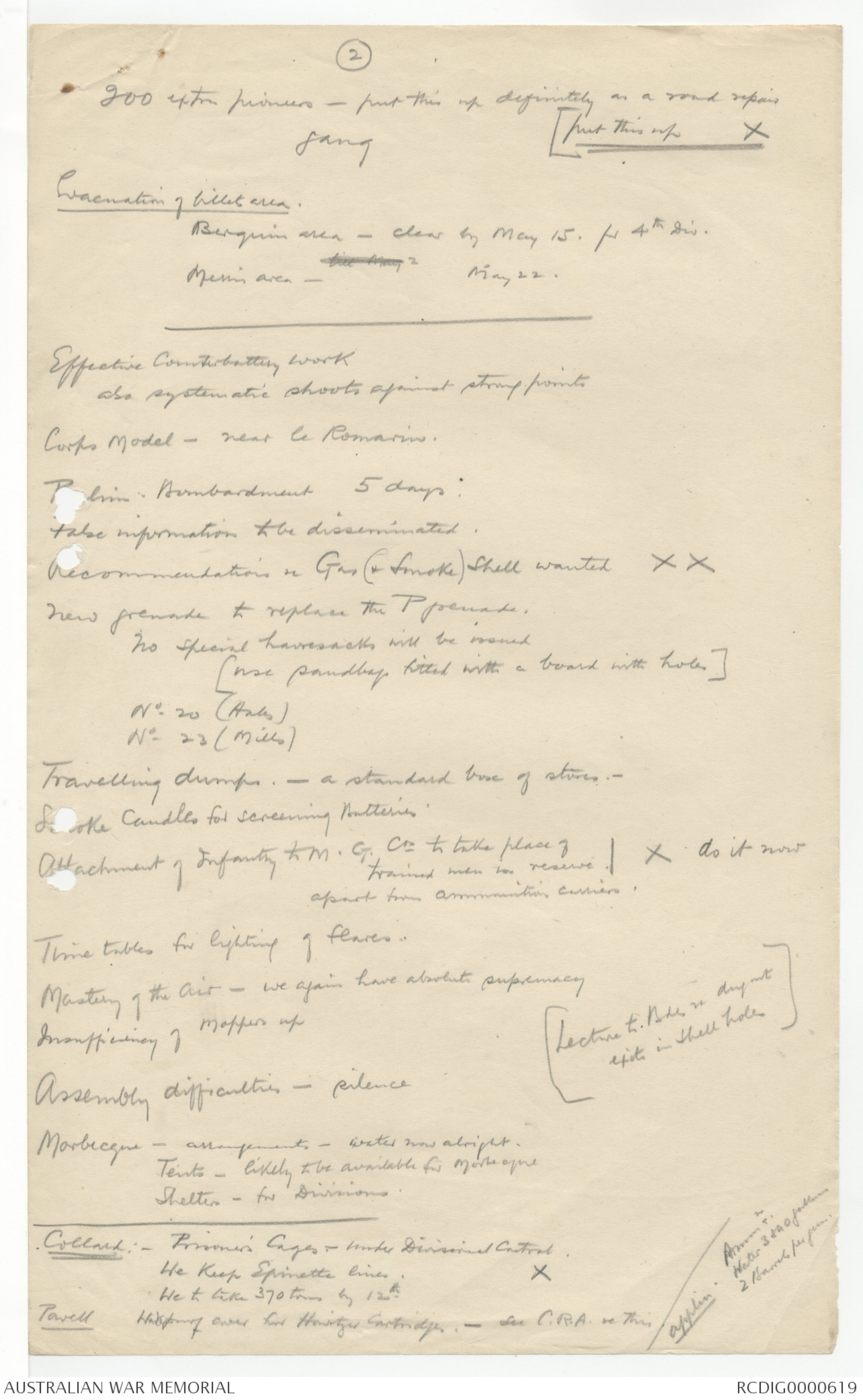
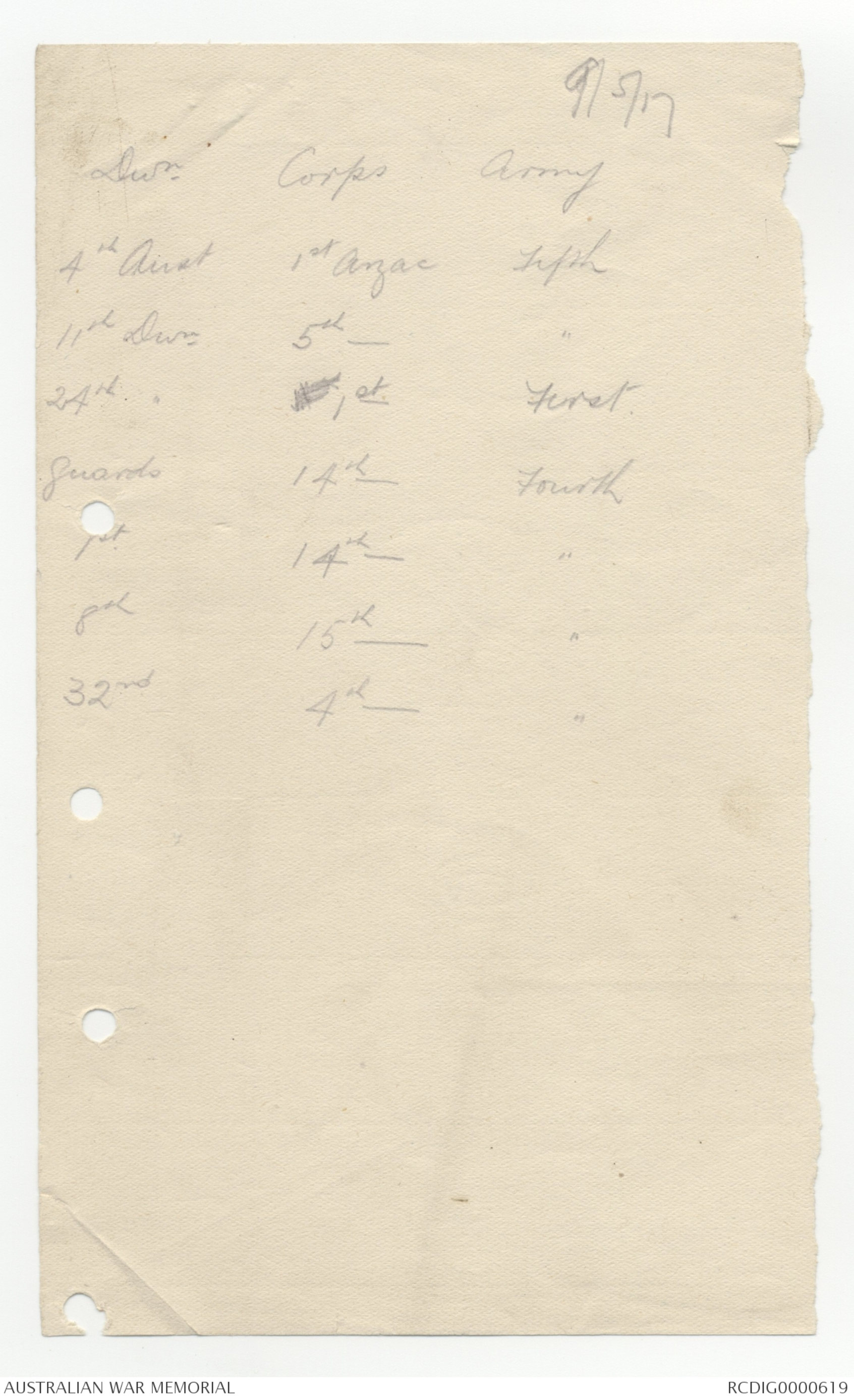
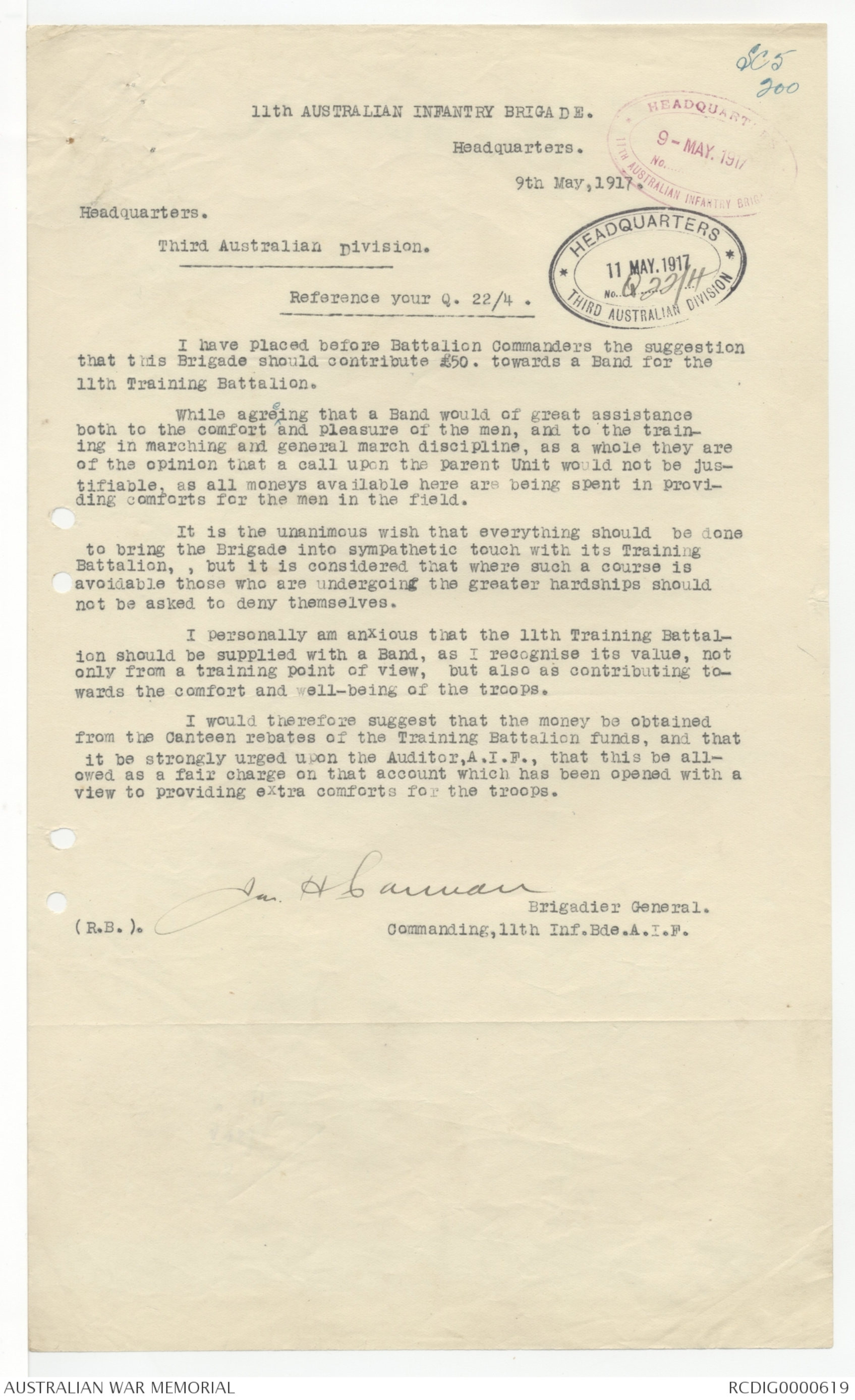
(3). 8-5-17.
Their machine gun barrage was 150 yards beyond their
artillery barrage. 75% of their M.G's were allotted for creeping
barrage, 25% to go forward into the consolidated line.
M.G. creeping barrage and artillery barrage moved up and down all
night during the period of consolidation. Their M.G.'s fired
1,200,000 rounds. These guns required two spare new barrels in
addition to the one in the gun. 20 belts per gun were filled;
essential to have plenty of belts ready filled. No good sending
up Vickers guns till the situation is clear, and consolidation
well under way. Necessary to have a repair shop for Vickers guns
fairly handy.
They had no carrying parties except for the 25% of the guns
going forward. For these they had 4 men per gun as carriers.
Each man carried 4 rifle grenades, and every man carried a tool of
sorts. This made too many tools and overloaded the men.
Three Brigades consolidated on a front of 3,700 yards.
On the fifth day one of these Brigades was withdrawn. Prior to
this, Brigades withdrew one Battalion each.
Their S.O.S. signal was a Red rocket aided by Very lights,
and every other sort of firework, including the Boche Red light.
It was easy to see them by day.
Visual signalling to balloons worked very satisfactorily.
No dumps for smaller Units than Battalions were made.
Carrying parties numbered 80 per Brigade, but besides these
each Brigade had one complete Battalion in case of necessity.
Artillery barrage lasted 4 to 6 minutes on the front line,
after that 3 minutes per 100 yards; later still 4 minutes per
100 yards. They found 4 minutes per 100 yards too fast during the
snow storm. It is their opinion that even in good weather, owing
to the shell holes, they could not go faster than 4 minutes per
100 yards.
Lifts were always on to definite objects, roughly 100 yards.
If intermediate ground had to be dealt with, certain guns were told
off to dwell on these points for a limited time, and then joined
the main creeping barrage. These were known as "rabbiters".
Their 4.5 barrage was closer than 200 yards in front of the
18-pr. creeper and crept with it. The numbers of their 18-prs.
allowed 1 for every 20 yards of front.
NOTES OBTAINED FROM CANADIAN CORPS.
Battalions used 96 cup attachments instead of 64 for the
Mills Grenade. They also used an 11 inch rod, which gave a range
of 160 yards. They found slings for Lewis Guns in order to enable
them to be fired from the hip, gave very good results. First and
Third Divisions swore by them.
Two Stokes Mortars per Battery of eight, went forward and
did good work against M.G.'s.
Attached is a copy of ammunition, etc. which was required.
This copy is to be returned to Canadian Corps Headquarters. I
will have a copy made, if you think it of value. In any case, I
will go through it carefully with REYNOLDS and check with our
amounts asked for.
Note to G.O.C. -
The above notes are not well sorted out, but have been done
in a great hurry, in order that you may look through them prior to
the Conference tomorrow.
GMC
[* SECRET *]
NOTES FROM CORPS COMMANDERS CONFERENCE.
9th. May, 1917.
1. Decided between Corps Commander, General RUSSELL, General MONASH,
and General POWELL, that timings of barrage shall be altered as
follows. -
Periods in left hand column to read as shown in right hand column.-
LEFT. RIGHT.
27 to 29 27 to 30
29 to 31 30 to 33
31 to 33 33 to 36
33 to 35 36 to 39
35 to 37 39 to 42
37 to 39 42 to 45
New Zealanders to go 100 yards in 4" through MESSINES.
2. Scope of attack. Second Army attack takes place prior to Northern
Army, but preparations in North continue, though Second Army have
precedence.
3. Reach BLACK line on first day. BLACK line may be slightly altered
in definition.
RED line completed at plus 35.
BLUE at plus 1.40, and slightly moved forward for the 25th.
Division. - Considerably moved forward for the IX Corps.
On reaching BLUE line there is to be a two hour halt, and then we
go forward to BLACK line.
RED line does not affect 3rd. Australian Division.
4. Hostile guns in Squares 27 and 28 to be captured.
5. 200,000 Fuze 106 will be made available for the Second Army.
6. Two Battalions of Tanks will similarly be made available. ANZAC
Corps will get 16 of these. There will be 16 more in Army reserve.
All Tanks are worked under Army orders.
7. Secrecy is now to be strictly maintained, and the letter saying we
had to impress the enemy with the idea that a big attack was brewing,
is apparently cancelled.
8. Intention and approximate date only to be told to those necessarily
concerned. Others merely to know active operations may be undertaken
at short notice.
9. It has been decided that our action, i.e. Second Army section, is
supplementary to other further South.
10. 4th. Australian Division will come North.
11. 8 Divisions in the FLETRE - RENNESCURE - MERRIS area.
12. First Army will take up to the LYS, and will be asked to put two
Battalions North of the LYS.
13. No 6" trench mortars will be available.
14. 9.45" trench mortars, with ^new ammunition, may be available.
15. Steady counter-battery work is to be undertaken, together with
destructive shoots from now on. Only limit to this is the life of
the guns.
16. It was ruled that our Southern group of mines should not be fired,
but all the others should be fired, and that a decision should be
come to with reference to our Northern mine.
P.T.O.
(2).
17. 20 miles of tram line will be available for the Army.
18. Programme of training will go on, but no more Brigades will be
able to go to TILQUES area.
19. Army will issue relief models made with cardboard, enough for
Brigade and Divisional Headquarters.
20. Corps cavalry will be used as such, not for traffic control work,
except their 100 dismounted men which will be available for this
duty.
21. Canadians used some 500 per Corps on traffic control.
22. Four extra Tunnelling Companies will be available. When operations
start, Tunnellers coming under Corps orders will -
(a). Examine dugouts in enemy's line for occupation by ourselves.
(b). Work on forward roads and water supply.
(c). Do work for tanks.
23. The question was raised whether 3rd. Australian Division should
keep up in their area, their surplus 200 Pioneers for work on
roads.
24. All troops of the Corps to be clear of the BERQUIN area by 15th.
May. - 32nd. Division replace 4th. Division in that area after
22nd. May.
By end of month we shall be in our fighting areas.
Corps has also to get clear of the MERRIS area.
25. Battalion Commanders must have photographs and Company Commanders
must be given an opportunity of seeing them. -
B.G., G.S. to see that photographs are sent to those who should
have them.
26. Model is being made at the Sand Quarries near DUKE OF CONNAUGHT'S
DUMP, ROMARIN. All details will not be completed on this model
until the end of the month.
27. Divisions to put up proposals with regard to projectors to be used
during preliminary bombardment and on "Z" day.
28. A new grenade (No. 27), vice the "P" bomb, for use as hand and
rifle grenade, may be available, but can't be counted on.
29. No special haversacks for carrying rifle grenades will be available.
A sandbag with a board at bottom with holes in it, is useful.
30. Necessary to impress all ranks with the fatal results of trusting
to bombs instead of rifles fire.
Hand bomb throwers to carry their rifles.
No. 20 grenade, viz., the Hale, and No. 23 grenade, viz., the
Mills, in proportion of 1 to 3 to be available for bombing squads.
Personally I did not understand this, as I thought we were all
using nothing but Mills. - In any case that the Hale would be 1
to 3, not the Mills.
31. Question of candles to put up smoke barrage in front of our
batteries was discussed and turned down as being not practical
for the "Magnum Opus".
G.O.C., R.A. stated he had sufficient for ordinary defensive work.
32. Corps Commander ruled that from now on Infantry should be attached
to Machine Gun Companies to replace trained men, who will be kept
back, vide S.S. 135, page 58, para 3, which says. -
"25% of Officers, Sergeants, and Corporals and Gunners must be left
behind of each company". - These ^extra men are apart from ammunition carriers.
P.T.O.
(3).
33. Time Table for lighting flares to reveal position of advanced
troops to aircraft will be issued by Corps.
34. The need for plenty of moppers up to look for dugouts in shell
holes was represented.
35. During assembly everyone to be absolutely silent. -
No bayonets to show up over the top of the trenches.
Movement to be as quiet as possible.
36. Points not decided were -
Whether in the event of mild hostile shelling during the approach
march we should retaliate in the ordinary way, or whether it
should be more than ordinary, or not al all. Similarly no action
was laid down for our artillery in the event of the enemy anticipating
us and putting down a heavy barrage on our troops while
assembling. -
These are points that may require to be considered.
37. Forest timber to be used for assembly trenches, if duckboards are
short.
38. Trench tramways to be taken right on up to our front line now, ready
to go forward.
40. Dumps of tramline material to be established well forward ready to
continue the work.
41. Each of the attacking Divisions will have a cage for prisoners -
ours is at RABOT
42. Our new transport lines are sanctioned and our area will be made
to include them.
43. 1600 petrol tins to be allowed for each Division for water carrying.
All Divisions in the Corps now have 2,100. We must see how
we really stand and arrange to all some "Water tins" instead of
petrol tins.
44. New Zealand Division have hooks on their Yukon Packs which they
say are far better than the eyelets as you can lash up much
quicker. Some one ought to see these.
45. 370 tons of ammunition must be dumped by the gun positions on the
12th instant. A.Q. 3rd Aust. Div. says we are already doing all ready to do this.
46. Dumps, at the Corps conference, were tabooed because down south
they did not work.
The point is, that down south they advanced a long way; we,
on the other hand, go 1000 yards. A dump within 1,000 yards is
a useful thing. Scattered dumps three to four thousand yards
back are obviously unsound. At that distance main dumps must
be used.
47. Corps Command laid stress on sign-boards for our roads.
48. It was ruled that the 3rd Aust. Div. should not only clear the
road toward MESSINES for traffic, but should proceed to make it
fit for horse transport.
49. Corps Commander laid stress on the necessity for weather-proof
cover for Howitzer ammunition. Will tarpaulins be available?
Best to scatter the ammunition in small dumps to avoid
explosions.
50. Canadians insisted that howitzer ammunition should be dumped in
its boxes. Other people say more liable to fire. The Canadian corps
-4-
50. (Contd.)
say that it is the fact that the boxes will not be returned which
makes the higher authority so insistent with reference to taking
the ammunition out of its boxes.
51. It was ruled that the 3rd Division need not pick up its wooden
rails to the batteries to replace them by metal, but it was
pointed out that a four to five hundred yard push on wooden rails
is heavy work. It is believed we have some 2000 yards of wooden
rails already dumped ready for the advance. G 1 to verify this
with C.R.E.
52. HYDE PARK CORNER to be kept clear of dumps in order that road
metalling may be put there. This was given out at the conference
in a very sketchy way, and the question will require to be carefully
gone into, as there are other things besides road metalling
to go forward. G 1 to get C.R.E. to take the matter up with C.E.
53. We may expect our extra artillery in, about the 15th.
54. G 1 with O.C. "A" Co. to put up exact details of the scheme for
4" Stokes amplifying former letter, also to put up scheme for
projectors and scheme for use of artillery gun shell. The
55. The question of digging assembly trenches early or late was
brought up. If they are dug early the enemy knows for a long
time that an attack will be coming sooner or later, unless he
imagines they are in order to bluff. This is impossible with the amount
of work we have going on behind. He is thus able to define the
flank of attack by the number of assembly trenches all along the
front, and group his guns and troops accordingly, days and perhaps
weeks before the attack takes place. If, on the other hand,
they are dug late, he will certainly expect an attack, but the
date will be just as much unknown to him as if dug early. The
only advantage of digging them early is that he might get accustomed
to the look of them. The advantage of digging them late
is - (a) that he may not have time to re-group guns, especially
machine guns, and troops.
(b) that he will not know where the flank of the attack will
rest until the last few days.
The advantage, therefore, appears to be on the side of digging
them late, especially as they are not so likely to get blown in
or require revetting in that case.
G 1 to go into the question of accommodation in assembly
trenches with Brigade Commanders and talk over with them the
Canadian form of assembly and removal of our own wire.
56. G 1 to put in for the necessary machine gun barrels.
57. It is possible from the lack of things that we may be asked for
a considerably number of men for work outside the Division during
the last week. It will be, therefore, necessary rather to
rush our own work from now on. There were several indications
at the corps conference of labour being required behind our area
proper.
58. It was stated at the conference that all picks and shovels in
the area were on loan to us from the Army. If any of these were are
withdrawn we may be short. C.R.E. therefore to collect and conceal
our numbers.
59. Corps require 4 or 8 Vickers Guns per attacking Brigade in order
to do a satisfactory overhead barrage. Corps will use the
whole of the 4th company and the whole of the company of the
Reserve Brigade for overhead barrages, according to APLIN.
This is not so in our own case.
60. APLIN said 15,000 in 24 hours was the maximum a machine gun
could fire. He gave details with regard to water and oil required
for each gun.
-5-
60. (Contd.)
Guns would be divided up into 8 per battery with an officer in
command of each battery.
Shrapnel proof belt-filling dugouts to be provided.
He had special views with regard to smoke and gas over the
hostile Machine Gun area.
APLIN requires M.Gs. to be allotted to him 10 days before
zero in order to practise their jobs.
9/5/17.
GMC
Corps Conference 9/5/17
4( shifting into area)
(tents or shelters)
2 Time Table
1 M.G. [?]
3 Roads - Sleepers.
Scope of Attack.
Messine attack before Northern attack
Reach final objective in one day.
Red line at Z + 35
Blue at Z + 1 hr. 40
After 2 hrs halt on blue - then to black.
Supply of 106 fuze forthcoming - 200,000 for the Army.
2 Nos of Tanks. - II Corps get 16 tanks
Secrecy. as to Intention & Date - tell only those essential.
Operations to be done at short notice - not before May 31.-
Arras-Vimy front is main front - & battle there is to continue.
Corps Commanders meeting:-
(4th Aust. Div. comes to II Corps reserve
(11th Div. IX
(24 X
(14* Corps comes in Army Sword Div) at Fletre.-
reserve 1st " )
8th " )
32nd ")
57th goes over to 1st Army.
1st Army to find 2 Bns & hold front N. of Lys.
6" T.M. not likely to be available - except experimentally.
P[[?]]artions for Northern Army will be continued, but ours will have precedence.
Artillery policy - steady counterbattery xxxx against targets likely to
have an influence on the operations, i.e. batteries & strong points.
Mines - Doyles, on Cario Farm - will reach front trench.
[*X*] Petit Douve - to be continued - consider this X
Antons - two to go up X
Factory Farm. -
Birdcage - to be reserved for a subsequent operation.
Tramlines - 20 miles available, 16th steel sleepers, 20th with wooden rails.
M.G. Barrages. -
Training to continue
Models. - cardboard - layered - for Brigades & Divisions.
Traffic Control - (not Corps Cavalry) --------------train 100 [*X*]
Extra tunnelers - used thus:-
A. Reconnaissance of enemy dugouts, & prepare them for us.
B. Forward roads & water supply
C. Working parties for Tanks.
(2)
200 extra pioneers - put this up definitely as a road repair
gang [put this up X
Evacuation of billet area.
Berquin area - clear by May 15. for 4th Div.
Messine area - till May 2 May 22.
Effective Counterbattery work
also systematic shoots against strong points
Corps Model - near le Romarin.
P[[?]]lim Bombardment 5 days.
False information to be disseminated.
Recommendation re Gas (& Smoke) shell wanted X X
New grenade to replace the P grenade.
No special haversack will be issued
[use sandbag fitted with a board with holes]
No 20 (Hales)
No 23 (Mills)
Travelling dumps. - a standard base of stores. -
Smoke Candles for screening batteries.
Attachment of Infantry to M.G. Cos to take place of |
trained men in reserve | X do it now
apart from ammunition carriers.
Time tables for lighting of flares.
Mastery of the Air - we again have absolute supremacy
Insufficiency of Moppers up
Assembly difficulties - silence
[* [Lecture to Bde in dugout]
[exits in shell hole] ] *]
Morbecque - arrangements - water now alright.
Tents - likely to be available for Morbecque.
Shelters - for Divisions.
Collard: -Prisoner's Cages - under Divisional Control.
We keep Epinette lines.
We to take 370 tons by 12th. X
Powell Had sprung over for Howitzer Cartridges.- see C.R.A. re this
[* Applin. Ammn.
Water 3840 gallons
2 barrels per gun. *]
9/5/17
| Divn | Corps | Army |
| 4th Aust | 1st Anzac | Fifth |
| 11th Divn | 5th - | " |
| 24th " | 1st - | First |
| Guards | 14th - | Fourth |
| 1st | 14th - | " |
| 8th | 15th - | " |
| 32nd | 4th - | " |
[* SC5
200 *]
11th AUSTRALIAN INFANTRY BRIGADE.
Headquarters.
9th May, 1917.
[*HEADQUARTERS
9-MAY 1917
No...
11TH AUSTRALIAN INFANTARY BRIGADE*]
Headquarters.
Third Australian Division.
Reference your Q. 22/4.
[*HEADQUARTERS
11 May, 1917
No Q22/4
THIRD AUSTRALIAN DIVISION*]
I have placed before Battalion Commanders the suggestion
that this Brigade should contribute £50. towards a Band for the
11th Training Battalion.
While agreeing that a Band would of great assistance
both to the comfort and pleasure of the men, and to the training
in marching and general march discipline, as a whole they are
of the opinion that a call upon the parent Unit would not be justifiable,
as all moneys available here are being spent in providing
comforts for the men in the field.
It is the unanimous wish that everything should be done
to bring the Brigade into sympathetic touch with its Training
Battalion, but it is considered that where such a course is
avoidable those who are undergoing the greater hardships should
not be asked to deny themselves.
I personally am anxious that the 11th Training Battalion
should be supplied with a Band, as I recognise its value, not
only from a training point of view, but also as contributing towards
the comfort and well-being of the troops.
I would therefore suggest that the money be obtained
from the Canteen rebates of the Training Battalion funds, and that
it be strongly urged upon the Auditor, A.I.F., that this be allowed
as a fair charge on that account which has been opened with a
view to providing extra comforts for the troops.
Jas. H Cannan
Brigadier General.
Commanding, 11th Inf. Bde. A.I.F.
(R.B.).
 Deb Parkinson
Deb ParkinsonThis transcription item is now locked to you for editing. To release the lock either Save your changes or Cancel.
This lock will be automatically released after 60 minutes of inactivity.